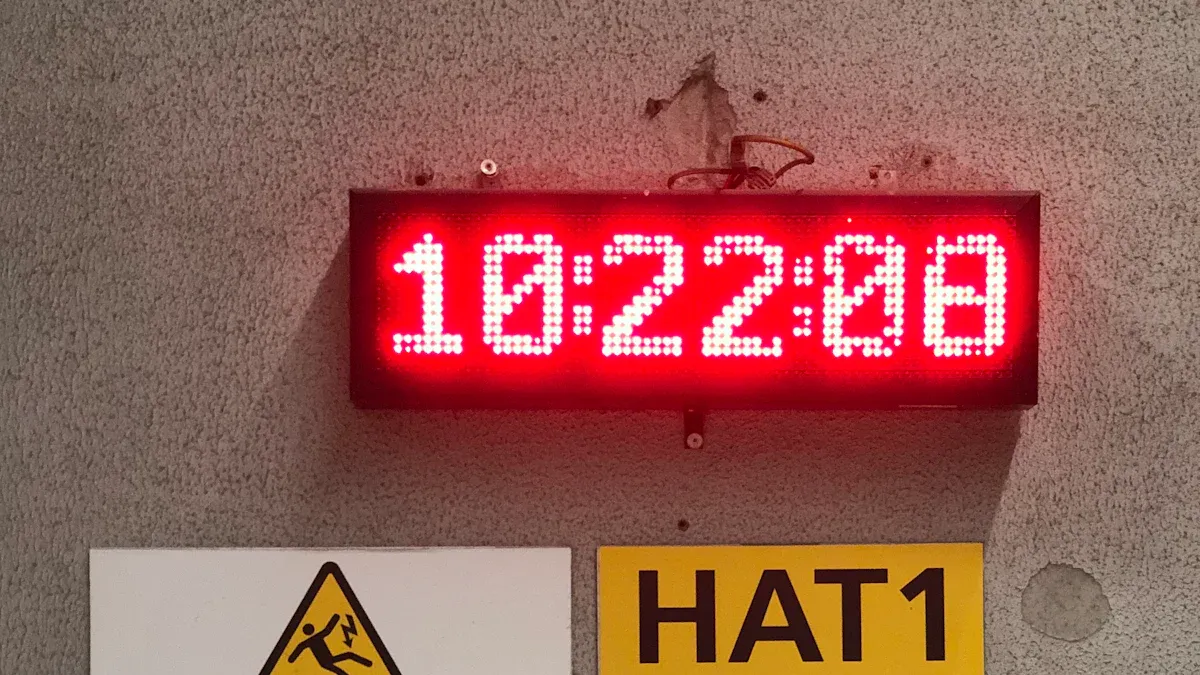
Elevator phones play a critical role in keeping residential buildings safe and compliant. Whether it’s an apartment elevator telephone or a handsfree elevator telephone, these systems ensure help is just a call away during emergencies. Regular maintenance also prevents issues with advanced models like stainless steel elevator telephones or emergency Tunnel Telephones.
Understanding Apartment Elevator Telephone Systems

Key Components of Elevator Phones
Apartment elevator telephones are designed to ensure reliable communication during emergencies. These systems consist of several essential components that work together seamlessly.
- Hardware Dimensions: Compact designs, such as 1 1/4″ wide by 6 1/8″ high by 6 3/8″ deep, make installation easy in tight spaces.
- Power Supply: They operate on 120V AC/12V DC power with UL-listed adapters, ensuring consistent performance.
- Connectivity: Modern systems use RJ-11 telco jacks for wired connections and 4G-LTE networks for wireless communication.
- Environmental Durability: These phones function reliably in temperatures ranging from 32°F to 90°F and humidity levels between 5% and 95%.
- Backup Power: With over 10 hours of battery life, they remain operational during power outages.
| Specification | Details |
|---|---|
| Dimensions | 1 1/4″ w x 6 1/8″ h x 6 3/8″ d |
| Power | 120V AC/12V DC 500mA, UL listed adapter |
| Connections | 1) RJ-11 telco jack |
| Environmental Conditions | 0°C to 32°C (32°F to 90°F), 5% to 95% humidity |
| Communication Network | 4G-LTE network |
| Backup Power | Over 10 hours of battery life |
These features make apartment elevator telephones a drop-in replacement for traditional POTS lines, offering superior voice clarity and compliance with FCC standards.
Emergency Communication Features
Elevator phones are more than just communication devices; they are lifelines during emergencies. These systems connect passengers directly to emergency services, ensuring help arrives quickly when needed.
- They prove invaluable during mechanical failures, medical emergencies, and power outages.
- Every state mandates their installation, highlighting their importance in residential buildings.
- Their wireless communication paths ensure uninterrupted service, even in challenging conditions.
Tip: Building managers should test these emergency features regularly to ensure they function flawlessly during crises.
By prioritizing these features, apartment elevator telephones enhance safety and provide peace of mind for residents.
Essential Maintenance Practices
Regular Inspections and Testing
Routine inspections and testing are the backbone of elevator phone maintenance. These practices ensure that systems remain functional and reliable when emergencies arise. Building managers should schedule regular checks to identify potential issues before they escalate.
Testing the communication system is crucial. A quick call from the elevator phone to the designated emergency contact can confirm that the connection works. It’s also important to verify the clarity of the audio. Poor sound quality could hinder communication during emergencies.
Inspections should also include checking the power supply. For instance, the backup battery must be tested to ensure it can sustain the phone during power outages. By addressing these aspects, building managers can prevent unexpected failures and keep residents safe.
Tip: Create a maintenance log to track inspection dates and findings. This helps ensure no detail is overlooked.
Cleaning and Preventing Wear
Elevator phones, especially in high-traffic residential buildings, require regular cleaning to maintain their functionality and hygiene. Dirt and grime can accumulate on the phone’s surface, potentially affecting its performance. Cleaning with soap and water removes dirt, while disinfecting kills germs, creating a safer environment for residents.
- Cleaning should always precede disinfecting.
- High-traffic elevators need more frequent cleaning schedules.
- Use non-abrasive cleaning agents to avoid damaging the phone’s surface.
Preventive maintenance also plays a key role in reducing wear. Scheduled inspections can uncover minor issues, like loose connections, before they lead to major malfunctions. Timely repairs ensure the elevator phone operates smoothly and extends its lifespan.
Note: Neglecting cleaning and preventive maintenance can lead to costly repairs or replacements.
Addressing Common Malfunctions
Even with regular maintenance, elevator phones can experience malfunctions. Some issues are more common than others, and knowing how to address them can save time and resources.
- Malfunctioning Door Operators: If the elevator doors take longer than usual to close, recalibration or replacement may be necessary.
- Excessive Wait Times: Long wait times could indicate a failing component. Addressing this promptly prevents service disruptions.
- Changes in Ride Quality: Hard stops or vibrations during operation often signal underlying problems. Fixing these early can avoid further damage.
Building managers should also monitor the performance of the apartment elevator telephone. Any drop in call quality or connectivity issues should be resolved immediately. Regular testing and swift action can minimize downtime and ensure the system remains reliable.
Tip: Partnering with a professional maintenance provider can help address complex malfunctions effectively.
Ensuring Compliance with Safety Standards
Adhering to Local and National Codes
Elevator phones must meet specific safety codes to ensure they function properly and protect residents during emergencies. These codes cover everything from installation to maintenance. Building managers should familiarize themselves with both local and national regulations to avoid compliance issues.
Here’s a quick look at some key codes and their purposes:
| Code/Regulation | Description |
|---|---|
| ASME A17.1/CSA B44 | Sets safety standards for elevators, including design, maintenance, and inspection. |
| National Elevator Code | Outlines essential safety requirements for elevator systems. |
| Local Building Codes | Provides specific rules for elevator installation based on regional needs. |
Following these codes ensures that systems like the apartment elevator telephone meet safety expectations. It also helps avoid fines or penalties during inspections.
Tip: Always consult a certified professional to verify compliance with these regulations.
Meeting ADA and Emergency Communication Requirements
Elevator phones must also comply with the Americans with Disabilities Act (ADA). This ensures that everyone, including individuals with disabilities, can use the system during emergencies.
Key requirements include:
- Accessibility for people who are deaf, hard of hearing, or speech impaired.
- Options for visual, text-based, and video-based communication.
- Technology that allows direct communication with emergency personnel.
By meeting these standards, building managers create a safer environment for all residents. It also demonstrates a commitment to inclusivity and safety.
Note: Regularly test these features to confirm they work as intended.
Maintaining Accurate Inspection Records
Accurate records are essential for staying compliant with safety standards. They also help track the performance of elevator phones over time. Building managers should adopt effective documentation practices to simplify inspections.
Here are some tips for maintaining thorough records:
- Conduct regular inspections to identify potential issues early.
- Keep all certificates of authority and related documents up to date.
- Use detailed checklists that align with state regulations to ensure nothing is overlooked.
Organized records make it easier to prove compliance during audits. They also provide a clear history of maintenance, which can be invaluable in case of disputes or emergencies.
Reminder: Digital tools can simplify record-keeping and reduce the risk of losing important documents.
Preparing for Emergencies

Backup Power Systems for Elevator Phones
Elevator phones must remain operational during power outages. Backup power systems ensure this critical functionality. Most modern elevator phones come equipped with rechargeable batteries that provide over 10 hours of backup power. These batteries kick in automatically when the main power supply fails.
Building managers should regularly inspect these backup systems. Testing the battery’s charge capacity and replacing it when necessary prevents unexpected failures. A well-maintained backup system guarantees that residents can always reach emergency services, even during blackouts.
Tip: Schedule battery tests every six months to ensure uninterrupted service during emergencies.
Testing Emergency Functionality
Testing the emergency features of elevator phones is essential. It ensures the system works as intended when needed most. Effective testing involves several steps:
- Press the ‘HELP’ button to confirm it connects to a 24-hour monitoring service.
- Verify that the operator can identify the building’s location or cab number, as required by ASME standards.
- Check if the system supports both text and audible communication, ensuring compliance with IBC and ASME A17.1-2019.
These tests confirm that the phone can handle real-life emergencies. Regular testing also helps identify and fix issues before they escalate.
Reminder: Document each test to track performance and compliance over time.
Educating Residents on Emergency Use
Residents should know how to use elevator phones during emergencies. Clear instructions inside the elevator can guide them. For example, labels like “Press HELP for Assistance” make the process straightforward.
Building managers can also hold brief informational sessions or distribute flyers. These efforts ensure residents feel confident using the system. Educating residents not only enhances safety but also reduces panic during emergencies.
Note: Simple, clear communication is key to effective resident education.
Leveraging Technology for Maintenance
Remote Monitoring Solutions
Technology has revolutionized how elevator phones are maintained. Remote monitoring solutions now allow building managers to oversee systems without being physically present. These tools provide real-time updates and diagnostics, ensuring issues are identified early.
Key trends shaping remote monitoring include:
- Cloud-based technology: Enables real-time data access and diagnostics from anywhere.
- Artificial Intelligence (AI): Predicts potential failures and prioritizes emergency calls.
- Machine Learning (ML): Improves system efficiency by detecting problems before they occur.
- Internet of Things (IoT): Integrates elevator phones with building management systems for seamless communication.
These advancements make maintenance more efficient and reduce the risk of unexpected failures.
Tip: Choose systems that support IoT and AI for smarter, more proactive maintenance.
Automated Alerts for Maintenance Needs
Automated alert systems have become a game-changer in elevator phone maintenance. For instance, the 2N® EasyGate IP gateway continuously communicates with the 2N® Elevator Center. It flags issues like backup power failures or connectivity problems, enabling quick resolutions.
FieldAx further enhances maintenance by providing real-time alerts. This proactive approach minimizes downtime and ensures technicians address problems before they escalate. Its seamless integration with existing systems also simplifies the transition to automated maintenance strategies.
Reminder: Automated alerts save time and improve reliability by addressing issues before they disrupt service.
Upgrading to Advanced Systems
Upgrading elevator phones is essential for meeting modern safety and efficiency standards. Aging infrastructure often struggles to comply with current codes, making upgrades necessary.
Emerging trends driving upgrades include:
- IoT integration and AI-driven controls for better performance.
- Energy-efficient solutions that lower operational costs.
- Compliance with ADA and other safety regulations.
- Growing tenant demand for modern amenities and increased property value.
Investing in advanced systems ensures reliability, safety, and long-term cost savings.
Note: Modernizing elevator phones not only enhances safety but also boosts resident satisfaction.
Selecting a Reliable Maintenance Partner
Evaluating Service Providers
Choosing the right maintenance partner for elevator phones can make all the difference in ensuring safety and reliability. Building managers should prioritize providers that focus on safety and compliance. Reliable partners monitor emergency communication systems and employ trained professionals to handle critical situations.
A good service provider will also have established processes for maintenance. These include clear procedures verified by experts and tailored safety checks for specific elevator models. Managers should review the frequency of inspections and the services included in the contract. Regular maintenance prevents malfunctions and ensures passenger safety.
Tip: Look for providers offering personalized services, like tailored cab maintenance, to meet the unique needs of your building.
Importance of Certifications and Experience
Certifications and experience are key indicators of a trustworthy maintenance partner. Providers with certifications like Advanced Emergency Medical Dispatch demonstrate their commitment to exceeding national safety standards. Experience in maintaining various elevator systems ensures they can handle complex issues effectively.
Compliance with ADA, ASME, and IBC codes is non-negotiable. A partner who understands these regulations can help avoid fines and ensure the safety of residents. Additionally, tracking performance metrics like service call frequency and elevator response times can reveal the provider’s reliability.
Note: An experienced partner not only ensures compliance but also enhances the overall performance of elevator systems.
Reviewing Service Agreements and Response Times
A well-structured service agreement is essential for effective maintenance. Contracts should outline the coverage duration, inspection schedules, and cancellation terms. Emergency repair response time is another critical factor. Ideally, repairs should begin within 90 minutes of a request.
| Metric | Benchmark | Strategy for Improvement |
|---|---|---|
| Emergency Repair Response Time | Under 90 minutes | Leverage IoT for live alerts and optimize technician dispatching |
Regularly monitoring response times and technician efficiency helps identify areas for improvement. Faster response times and efficient technicians lead to better customer satisfaction and safer buildings.
Reminder: Always review service agreements carefully to ensure they align with your building’s needs.
Maintaining elevator phones is vital for safety, compliance, and reliability. Regular upkeep ensures these systems work during emergencies and meet safety standards.
- Building managers should:
- Schedule routine inspections.
- Partner with certified professionals.
Reminder: Proactive maintenance saves costs, boosts safety, and provides peace of mind for residents.
FAQ
What should building managers do if an elevator phone stops working?
Managers should contact a certified maintenance provider immediately. They can diagnose and fix the issue to restore functionality quickly.
Tip: Regular testing can help catch problems early.
How often should elevator phones be inspected?
Elevator phones should be inspected at least once a month. Frequent checks ensure they remain operational and compliant with safety standards.
Can elevator phones work during power outages?
Yes, most modern elevator phones have backup batteries. These batteries provide over 10 hours of power, ensuring uninterrupted service during outages.
Reminder: Test backup systems every six months to avoid surprises.


